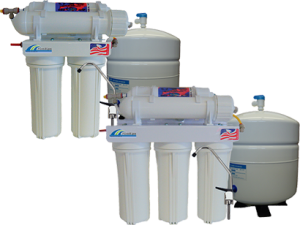Reverse osmosis is based on the process of osmosis. Osmosis involves the selective movement of water from one side of a membrane to the other. Reverse osmosis is also known as hyper filtration. It is the same process as used by a human body to filter out contaminants. Particles or impurities can be removed from a solution through the process of reverse osmosis. The solution is passed through a semi-permeable membrane. The semi permeable membrane allows the passage of water but rejects ions like sodium and calcium or contaminants like bacteria or urea. Gore-tex is a common semi permeable membrane. Gore-tex fabric contains an extremely thin plastic film into which billions of small pores have been cut. The pores are big enough to let water vapor through, but small enough to prevent liquid water from passing through.Have a look at reverseosmosis for more info on this.
 Reverse osmosis involves a process known as crossflow, which allows the membrane to clean itself. As fluid passes through the membrane some of the fluid continues downstream, sweeping the contaminants away from the membrane. For reverse osmosis to occur, pressure must be applied to the fluid. The most common method of applying pressure is the use of a pump. The higher the pressure applied, the greater the force created. As the concentration of the fluid being rejected increases, the force required to continue concentrating the fluid increases. Pressure is exerted on the area containing the concentrated solution, which forces the water molecules across the membrane to the area of the fresh water.
Reverse osmosis involves a process known as crossflow, which allows the membrane to clean itself. As fluid passes through the membrane some of the fluid continues downstream, sweeping the contaminants away from the membrane. For reverse osmosis to occur, pressure must be applied to the fluid. The most common method of applying pressure is the use of a pump. The higher the pressure applied, the greater the force created. As the concentration of the fluid being rejected increases, the force required to continue concentrating the fluid increases. Pressure is exerted on the area containing the concentrated solution, which forces the water molecules across the membrane to the area of the fresh water.
Reverse osmosis rejects bacteria, salts, sugars, proteins and other elements that have a molecular weight of greater than 150-250 Daltons. The separation of ions with reverse osmosis is aided by charged particles. The membrane rejects charged ions such as salts. The process of reverse osmosis is of immense benefit to mankind.